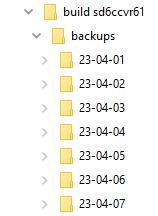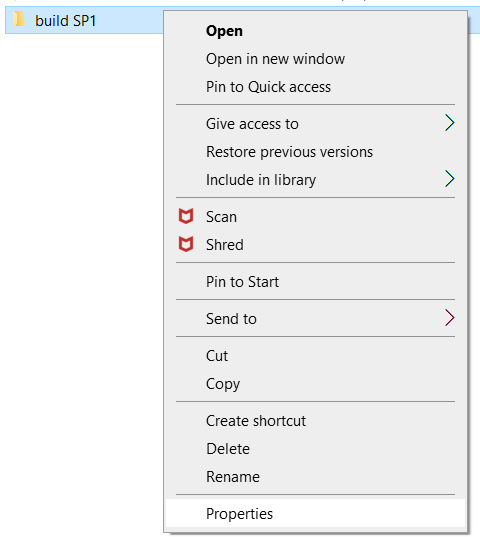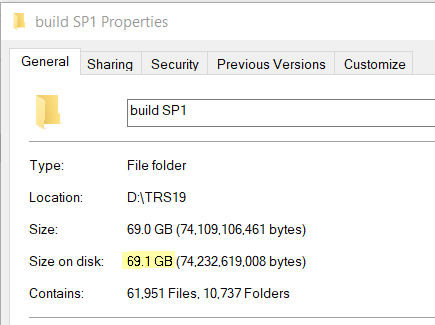The information in this Wiki Page applies to TANE, TRS19, Trainz Plus and TRS22. This guide will explain automatic and manual backups in Trainz.
| Main Points: |
 |
Trainz will automatically backup your current route and session in Surveyor while you work. You can set the number of backups created each day |
 |
You can use Content Manager to manually create backups of routes, sessions and assets as often as you need |
 |
Both the manual and automatic backups can be restored to Trainz by Content Manager |
 |
You can backup all your user data (built-in assets, DLS downloads, DLC purchases, your own creations) |
Automatic Backups vs Manual Backups
| |
Automatic Backups |
Manual Backups |
Pros
 |
- set and forget - no need to remember to perform the backups
- backups are stored in a set location
- automatic restore after a crash
|
- you control where the backups are stored and for how long
- you control the backup file names
- any assets can be backed up, not just routes and sessions
|
Cons
 |
- identifying the exact backup file to restore may not be easy
- only routes and sessions can be backed up
- last 7 days of backups only are kept
|
- you have to remember to perform the backup
- you have to remember where you stored the backups
- manual restore after a crash
|
|
Automatic Backups
Creating Automatic Backups
| In Summary: |
 |
Only a set number of backups are created each day |
 |
Only 7 days of backups are kept |
This is a Set and Forget operation. You simply tell Trainz how many backups you want created each day and the program takes care of the rest.
Only the last 7 days of backups are kept and this number cannot be changed.
Restoring Automatic Backups
The automatic backups are stored in a backup folder in your Trainz local data folder. The location of this folder is held in your Launcher - Trainz Settings - Install tab.
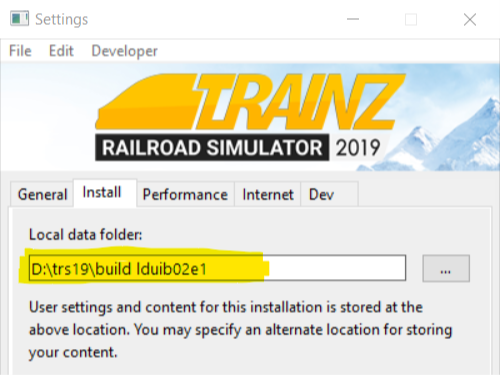 |
 |
Steps:
 |
Highlight the Local Data Folder address and copy to your OS clipboard - press Ctrl C |
 |
Open Windows Explorer and paste ( Ctrl V ) the address into the Address Bar
|
|
|
This folder can also found using Windows Explorer by following a similar folder path as shown below.

Where idname is the first 5 characters of your Windows logon name and random will be a random sequence of letters and numbers identifying the Trainz Build Number.
 |
Notes:
|
|
|
 |
Notes:
The "usual" method of dragging and dropping the backup folder into Content Manager to restore it no longer works. Instead the following method is recommended.
|
|
More details, including tips on troubleshooting, can be found in the Trainz Knowledge Base at  Restoring Backups
Restoring Backups
Manual Backups
| In Summary: |
 |
You control the number and frequency of backups |
 |
You control the backup location and filenames |
 |
Assets, not just routes and sessions can be backed up |
Creating Manual Backups
 |
Manual backups are stored as .CDP files |
 |
Many assets can be stored in a single .CDP file |
|
 |
Steps:
 |
open Content Manager and use a search filter to identify the assets to be backed up. Some examples:-
|
 |
 |
to show all assets that have been altered today |
 |
 |
to show all installed routes that are yours |
|
 |
highlight the asset or assets (more than one asset can be included in each backup file) |
 |
right mouse click on one of the highlighted assets and select Export to CDP
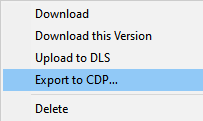 |
 |
select a drive, folder and enter a backup filename |
|
Restoring Manual Backups
 |
Simply drag and drop the backup CDP file or files into Content Manager |
|
 |
Steps:
|
Backup Plan Basics
 |
If you are using a manual backup method then devise a simple backup plan and stick to it |
The most important parts of any backup plan are:-
- make regular backups - how often will depend on the complexity of the project
- keep duplicate sets of backups including on offline storage
- keep previous backup sets, not just the latest ones - how many past sets you will want to keep will depend on factors such as available storage
- have a simple but consistent file naming system to be able to quickly identify the backup you need to restore lost work
 |
Sample Backup Plan:
- on a drive that is always attached to your system create a Project Backups folder
- in this folder create another folder named Today
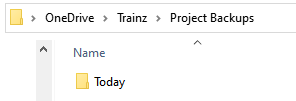
- use this folder to store your regular backups for today. For example, when you take a break and exit from Surveyor, start Content Manager and backup the current project (e.g. a route, a session or both) to the Today folder
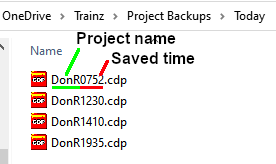
- name each backup using the name of the project and the time as shown in the example above
 |
Why Keep Separate Time Backups For The Same Day?
Suppose that after your first backup of the day, at say 07:52, you decided to make some significant changes to your route. The later backups made at 12:30 and 14:10 included this change. By 17:00 you decide that this major change is not working and you need to return the route to its starting state. If your only backup was the last one you had made at 14:10 then you could not restore the route to its starting state.
|
- at the end of each day copy the Today folder to another drive (external or internal) into a folder also called Project Backups
- rename the Today folder on the 2nd drive to a format that identifies the date of the backups it contains (using the yyyy-mm-dd format) as shown below
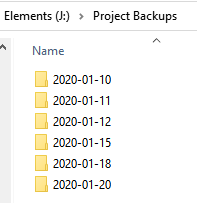
- copy this renamed folder to an external detachable drive into its Project Backups folder - this will give you a second backup copy
- when starting work the next day, delete the contents of the Today folder on your main drive and make the first backup of the day using the project assets in their initial state for the day
 |
How Long Should You Keep The Daily Backups?
The ideal answer is until after the project has been finished but in reality it will depend on your available storage space.
- Once the project has been completed then the backup folders and files can be deleted
- If there is insufficient space to keep a large number of backups, then delete the oldest backup folders first
If a decision is later made to restart work on the route (e.g. to update it after a new version of Trainz has been released) then it would be considered to be a brand new project and the backup procedure can be restarted from that point. |
|
Backing Up and Restoring Picklists
 |
Picklists have to be exported and imported as text files |
Picklists cannot be backed up manually using .CDP files. They must be exported as text files.
 |
Detailed instructions on backing up and restoring Picklists as text files can be found on the Trainz Wiki Page at:-
|
Backing Up All Your User Content
 |
You can backup ALL your installed content including built-ins and DLC |
| You can make a backup copy of all your installed content (buildings, tracks, rolling stock, trees, routes, sessions, etc, etc). Everything you have downloaded and installed from the DLS and other web sites, all the built-in content and all your DLC packages. Also included will be all the screenshots you have captured and your automatic backups. In short, everything but the program "executables" and utilities that form the Trainz program itself.
All of this data is stored in your Local Data Folder.
|
| Warning: |
 |
Be aware that this could be a very large quantity of data that could take a lot of time and space to backup |
| |
 |
 |
|
|
Trainz Wiki
 |
More Tutorials and Guides to Using Trainz
|
This page was created by Trainz user pware in January 2020 and was last updated as shown below.


![]()


Restoring Backups






